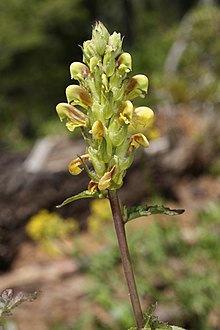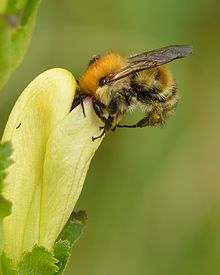Pedicularis
| Pedicularis | |
|---|---|

| |
| Pedicularis bracteosa | |
| Scientific classification | |
| Kingdom: | |
| (unranked): | |
| (unranked): | |
| (unranked): | |
| Order: | |
| Family: | |
| Genus: | Pedicularis |
| Species | |
|
500+, see text | |
Pedicularis is a genus of perennial green root parasite plants currently placed in the broomrape family Orobanchaceae (the genus previously having been placed in Scrophulariaceae[1] sensu lato).




Description
Between 350 and 600 species are accepted by different authorities, mostly from the wetter northern temperate zones, as well as from South America. The highest diversity is in eastern Asia, with 352 species accepted in China alone.[2]
The common name lousewort, applied to several species, derives from an old belief that these plants, when ingested, were responsible for lice infestations in stock.
Pollination
Bombus polaris has an essential role in the pollination of the large zygomorphic flowers of Pedicularis.[3] B. polaris has a special adaption that allows it to work the spikes of Pedicularis from the bottom towards the top.[3]
Selected species
- Pedicularis acaulis
- Pedicularis amoena
- Pedicularis arguteserrata
- Pedicularis ascendens
- Pedicularis asparagoides
- Pedicularis asplenifolia
- Pedicularis attollens (Little elephant's head)
- Pedicularis baumgartenii
- Pedicularis brachyodonta
- Pedicularis bracteosa (Fern-leaf, Towering, or Bracted Lousewort)
- Pedicularis canadensis (Canadian Lousewort)
- Pedicularis centranthera
- Pedicularis comosa
- Pedicularis compacta
- Pedicularis contorta (Coiled Lousewort or White-coiled Beak Lousewort)
- Pedicularis dasyantha (Woolly Lousewort)
- Pedicularis dasystachys
- Pedicularis densiflora (Indian Warrior)
- Pedicularis dudleyi (Dudley's Lousewort)[4]
- Pedicularis elegans
- Pedicularis elongata
- Pedicularis exaltata
- Pedicularis ferdinandi
- Pedicularis flammea (Redrattle)
- Pedicularis foliosa (Leafy Lousewort)
- Pedicularis furbishiae (Furbish's Lousewort)
- Pedicularis friderici-augusti
- Pedicularis graeca
- Pedicularis groenlandica (Elephant's Head)
- Pedicularis gyroflexa
- Pedicularis hacquetii
- Pedicularis heterodonta
- Pedicularis hirsuta (Hairy Lousewort)
- Pedicularis howellii (Howell's lousewort)
- Pedicularis julica
- Pedicularis kaufmannii
- Pedicularis kerneri
- Pedicularis labradorica
- Pedicularis lanceolata
- Pedicularis langsdorfii
- Pedicularis lapponica (Lapland Lousewort)
- Pedicularis leucodon
- Pedicularis limnogena
- Pedicularis mixta
- Pedicularis oederi (Crimson-tipped Lousewort)
- Pedicularis ornithorhyncha (Ducksbill Lousewort)
- Pedicularis orthantha
- Pedicularis palustris (Marsh Lousewort)
- Pedicularis pectinata
- Pedicularis petiolaris
- Pedicularis physocalyx
- Pedicularis portenschlagii
- Pedicularis procera (Giant Lousewort)
- Pedicularis pyrenaica
- Pedicularis racemosa (Parrot's Beak)
- Pedicularis rainierensis (Mount Rainier lousewort)
- Pedicularis recutita
- Pedicularis resupinata
- Pedicularis rosea
- Pedicularis rostratocapitata
- Pedicularis rostratospicata
- Pedicularis sceptrum-carolinum (Moor-king Lousewort)
- Pedicularis schizocalyx
- Pedicularis semibarbata (Pinewoods lousewort)
- Pedicularis sibthorpii
- Pedicularis sudetica (Fernweed, Sudeten lousewort or Sedetic lousewort)
- Pedicularis sylvatica (Common Lousewort)
- Pedicularis tuberosa
- Pedicularis uralensis
- Pedicularis verticillata (Verticillate Lousewort)
References
- ^ IPNI (Pedicularis assigned to Scrophulariaceae)
- ^ Species accepted by the Flora of China (not detailed here; see external links for details).
- ^ a b Kevan, Peter G. (1972-11-01). "Insect Pollination of High Arctic Flowers". Journal of Ecology. 60 (3): 831–847. doi:10.2307/2258569. JSTOR 2258569.
- ^ The Status of Rare, Threatened, and Endangered Animals and Plants of California (PDF), California Department of Fish and Game, Rare Plant Program, 2000, p. 181, retrieved 2007-11-16
